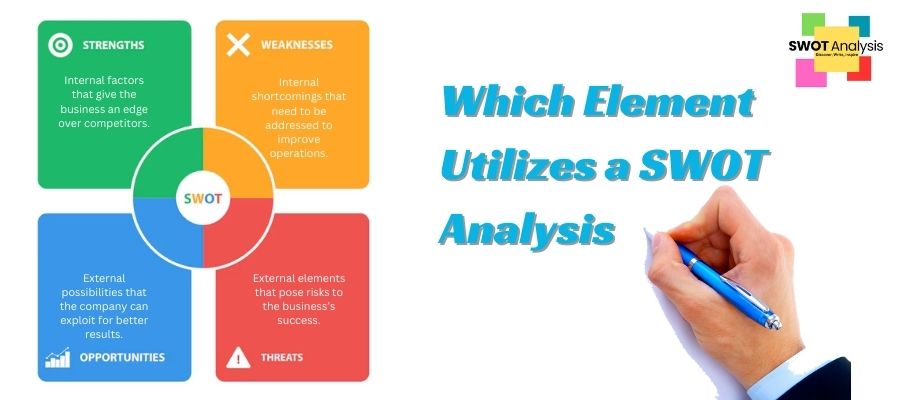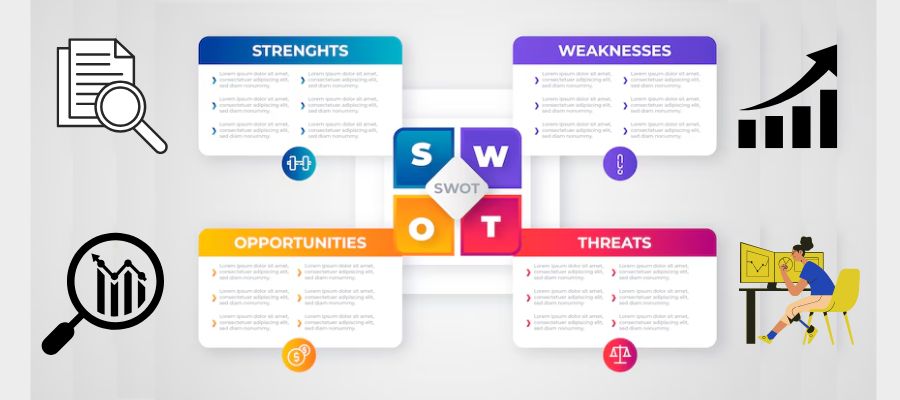SWOT Analysis is a strategic planning framework that helps organizations evaluate their Strengths, Weaknesses, Opportunities, and Threats. This analysis considers both internal and external factors to give businesses a clear picture of their current position and future potential. By performing a SWOT analysis, companies can develop effective strategies, capitalize on strengths, and mitigate potential risks.
Table of Contents
1. Overview: Which Element Utilizes a SWOT Analysis?
In a SWOT Analysis, each element—Strengths, Weaknesses, Opportunities, and Threats—plays a distinct role in helping an organization understand its market position and formulate a plan. Typically, these elements are utilized in strategic planning, marketing, project management, and personal development. Each component provides insight into what actions are needed to improve market position or achieve specific business goals.
2. Understanding the Components of SWOT Analysis
A. Explanation of Strengths
Strengths represent the internal factors that give a business a competitive edge. Examples of strengths include strong brand recognition, a loyal customer base, or unique product advantages. Identifying strengths allows a business to leverage its core assets and capabilities to achieve objectives.
B. Explanation of Weaknesses
Weaknesses are internal factors that may limit a company’s ability to perform optimally. These could include limited financial resources, outdated technology, or lack of skilled personnel. Recognizing weaknesses helps a company address areas that require improvement and take proactive steps to overcome them.
C. Explanation of Opportunities
Opportunities refer to external conditions that a business can capitalize on to grow. This could mean tapping into an emerging market, responding to customer demand for a new product, or utilizing advances in technology. By identifying opportunities, companies can take strategic actions to expand and improve their market share.
D. Explanation of Threats
Threats are external factors that could hinder a company’s success. Examples include new competitors, economic downturns, or changing regulations. A thorough analysis of threats enables companies to develop contingency plans to protect against potential risks.
E. How These Components Interact Within an Organization
The components of a SWOT analysis work together to create a comprehensive view of an organization’s environment. Strengths and opportunities can be combined to create a strong growth strategy, while weaknesses and threats indicate areas that need strategic mitigation. The interaction of these components helps an organization achieve its long-term goals by making informed decisions based on a thorough understanding of its position.
3. Applications of SWOT Analysis in Various Elements
SWOT Analysis can be applied to different areas of business and personal growth:
A. Business Strategy
- Market Positioning: By identifying strengths and weaknesses, a business can position itself effectively in the market. This positioning helps in differentiating products or services from competitors.
- Competitive Analysis: SWOT Analysis aids in understanding competitors’ strengths and potential market opportunities. This enables a business to define a strategy that targets specific market segments.
B. Project Management
- Risk Assessment: Project managers use SWOT to identify threats and weaknesses that may impact a project’s success. This risk assessment allows them to create contingency plans to address potential risks.
- Resource Allocation: SWOT Analysis helps determine the best allocation of time, budget, and other resources to maximize project efficiency.
C. Personal Development
- Career Planning: Individuals can use SWOT to assess their strengths and weaknesses, identifying areas for improvement in their careers. This helps in setting realistic and achievable career goals.
- Skill Enhancement: By recognizing personal weaknesses, individuals can focus on developing new skills that will strengthen their professional profile and open up new opportunities.
4. Case Studies of Successful SWOT Analysis Implementation
A. Example from a Well-Known Corporation
Apple Inc. used SWOT Analysis to identify its strengths in brand loyalty and innovative technology. By focusing on these strengths, Apple was able to introduce products like the iPhone, which gave it a competitive edge and revolutionized the market.
B. Example from a Non-Profit Organization
The Red Cross identified its opportunities in community outreach and global partnerships. By leveraging these, the organization has been able to extend its reach and provide aid to millions in times of crisis.
C. Lessons Learned from These Case Studies
These case studies highlight how a structured SWOT analysis can guide organizations in strategic decision-making and resource allocation. Both Apple and the Red Cross demonstrated how effective SWOT analysis can enhance growth and mission delivery by focusing on strengths and addressing weaknesses.
Also Read: Which Statement Best Describes Opportunities in a Swot Analysis
Conclusion
SWOT Analysis is an invaluable framework for any organization or individual looking to assess their position and identify strategic actions. By examining strengths, weaknesses, opportunities, and threats, companies can make well-informed decisions that drive growth and sustainability. Consistent use of SWOT Analysis enables organizations to respond effectively to market changes, remain competitive, and ultimately achieve their objectives.
FAQ
Q. Which Business Elements Can Utilize a SWOT Analysis?
A. SWOT Analysis can be utilized in strategic planning, marketing, project management, and personal development to evaluate internal and external factors affecting performance.
Q. How Can Marketing Teams Benefit from a SWOT Analysis?
A. Marketing teams can benefit by identifying strengths to leverage, understanding weaknesses to address, and analyzing growth opportunities. This helps them create an effective marketing plan aligned with business goals.
Q. Can a SWOT Analysis Help with Financial Planning?
A. Yes, SWOT Analysis helps financial planners assess internal strengths and external threats, guiding budget allocation and investment decisions for better financial outcomes.
Q. Is a SWOT Analysis Useful for Small Businesses?
A. Absolutely. Small businesses can use SWOT to understand their market position, identify areas for improvement, and develop strategies to build a competitive edge.
Q. Who Should Be Involved in a SWOT Analysis?
A. A SWOT Analysis should include key stakeholders like senior management, department heads, and, if possible, external consultants to provide a comprehensive perspective on the business environment.





